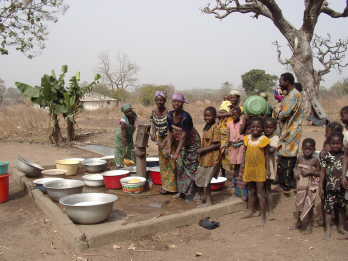|
Dr. Elisabeth Zuber-Knost Kaiserstraße 12 | |
|
The international research project AMMA is aimed at better understanding the monsoon and improving its predictability. The results obtained by regional climate modeling under the project are alarming: In West Africa, shortage of water resources has to be expected. On the other hand, progress in the predictability of monsoon and climate development will allow for improved protection measures and adaptation strategies in the future. |
For details, please contact: Forschungszentrum Karlsruhe Postfach 3640 |
|
People living south of the Sahara are dependent on the seasonal monsoon rains to cover their vital and nutrition needs. In worldwide comparison, these rains are subject to extremely high, largely natural fluctuations. This was reflected in particular by the long draught in the Sahel zone south of the Sahara in the 1970s and 1980s, which affected millions of people. Now, this typical unreliability of precipitation in the monsoon regions of the earth is additionally affected by accelerated anthropogenic climate change. In summer 2006, German researchers participated in an extensive measurement campaign on the land, sea, and in the air of West Africa under the large-scale international research project AMMA (African Monsoon Multi-disciplinary Analysis). AMMA is aimed at better understanding the monsoon and improving its predictability with models in order to take specific precautions in drinking water supply, agriculture, and the health care sector. Regional climate models generated under AMMA yield alarming findings: Climate changes and changes of land use will lead to a shortage of water resources and reduced nutrition safety in West Africa. On the other hand, the progress achieved in the forecast of the monsoon and climate development will allow for improved protection measures and adaptation strategies. The AMMA research project is carried out by 140 institutions from 25 countries. The following German institutions are involved: The Institute for Geophysics and Meteorology of the University of Cologne, the Meteorological Institute of the University of Bonn, the Institute for Environmental Physics of the University of Bremen, the Institute for Atmospheric Physics of the German Aerospace Center, Oberpfaffenhofen, the German Weather Service, Offenbach, the Institute of Meteorology and Climate Research of the Forschungszentrum and Universität Karlsruhe, the Leibniz Institute for Marine Sciences at the University of Kiel, the Institute for Atmospheric Physics of the University of Mainz, the Meteorologcal Institute of the University of Munich, the Institute for Geography of the University of Würzburg, and the Center for Development Research, Bonn. More than 400 participants, of them, many from the countries affected, will present the latest results of their work and plan the cooperation for the next years at the conference at the Forschungszentrum Karlsruhe. Further information on the results of AMMA can be found on the internet: http://www.amma-international.org/ The Karlsruhe Institute of Technology (KIT) represents the merger of the Universität Karlsruhe with the Forschungszentrum Karlsruhe. Altogether, it has 8000 employees and an annual budget of 600 million Euros. In the KIT, both partners are bundling their scientific competences and capacities, establishing optimum research structures, and developing joint strategies and visions. The KIT will be an institution of internationally excellent research and teaching in natural and engineering sciences. KIT shall attract the best experts from all over the world, set new standards in teaching and promotion of young scientists, and establish the leading European center in the field of energy research. KIT will assume a leading role in nanosciences worldwide. It is the objective of KIT to be one of the most important cooperation partners of industry. | |
Press Release 26/2007
Predictability of Draught and Floods
The Monsoon in West Africa and Its Impacts - International Conference at the Forschungszentrum Karlsruhe from November 26 to 30

Intensity of the annual monsoon rains is of vital importance to the rural population in West Africa
(photo by: AMMA International)
(photo by: AMMA International)
Hartlieb, November 26, 2007
Contact:
Christian Könemann
Chief Press Officer
Phone: +49 721 608-41190
Fax: +49 721 608-43658
christian koenemann ∂does-not-exist.kit edu
Contact for this press release:
Inge Arnold
Presse, Kommunikation und Marketing (PKM)
Phone: +49 721 608-22861
Fax: +49 721 608-25080
inge arnold ∂does-not-exist.kit edu
Presse, Kommunikation und Marketing (PKM)
Phone: +49 721 608-22861
Fax: +49 721 608-25080
inge arnold ∂does-not-exist.kit edu
